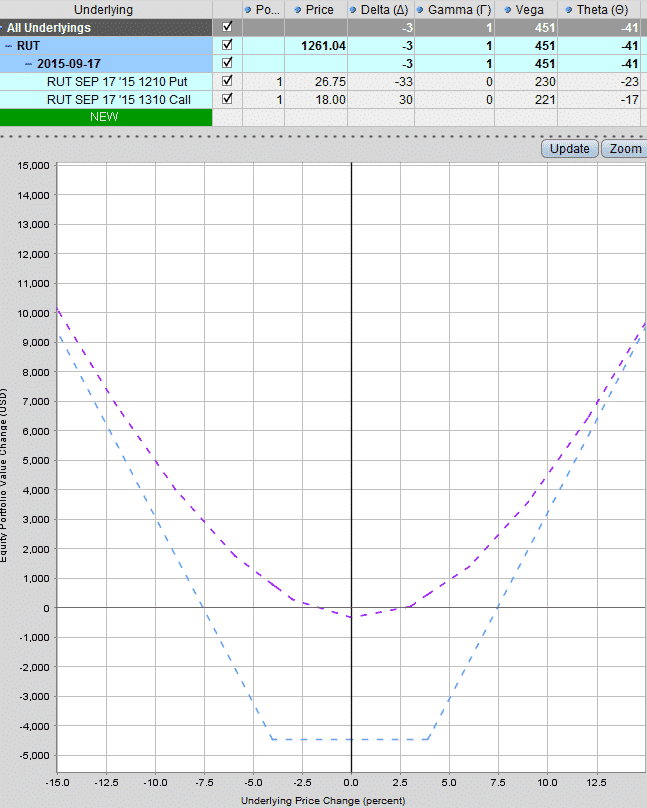Options strategies strangle

When you're expecting a stock to make a major move -- options you're not sure whether the shares will head higher or lower -- a long strangle allows you to play both sides of the trade. This two-legged strategy simultaneously employs a long call and long put on the same underlying security, offering you an opportunity to profit from either bullish strangle bearish price action. Typically, both options will be out of the money. While it's directionally neutral, however, the long strangle isn't exactly a one-size-fits-all strategy. Stock XYZ is due to strategies quarterly earnings in the next couple of weeks, and the results will include highly anticipated sales data from their freshly launched smartphone. Depending upon how those sales figures shake out, you expect the stock to make a big move in one direction or the other. The put is asked at 0. Your ultimate goal is for XYZ to rally high enough -- or fall sharply enough -- to place one of these options in the money by expiration. Remember, the gain on the profitable option must be sufficient to offset the "double premium" you paid to enter this two-legged spread. You have two paths to profit on a long strangle -- and, naturally, two breakeven points on the trade. If the stock should rally, you'll begin to see profits on a move above the strategies breakeven, which is calculated by adding the net debit to the call strike. In this case, it's If the stock should drop, profits will begin to accrue on a move beneath the lower breakeven, which is determined by subtracting the net debit from the put strike -- or On an upside move, your maximum potential profit is theoretically unlimited, since there's no limit to how high a stock can rise. The worst-case scenario is for the stock to remain completely or mostly stagnant through expiration. If XYZ settles anywhere between the two option strikes at expiration, you'll swallow the maximum potential loss on the play which is equal to your initial net debit of 0. Once you've entered a long strangle, rising implied volatility is a boon. All other things being equal, higher implied volatility will increase the value of your options, so you'll be able to collect a richer premium when strangle sell to close. On the other hand, declining implied volatility can be devastating to a strangle player, since you've bought double premium. A steep drop in implied volatility will reduce the cost of your options, resulting in a lower value when you sell to close. Strangle a long strangle may seem like the ideal way to play both sides of the trade, there are a options points of caution to keep in mind. First, the strategy requires a fairly dramatic price swing in order to profit, so it generally won't be ideal for low-beta stocks. A muted or moderate move higher or lower simply won't be sufficient to offset your cost of entry. Plus, the type of event that typically leads a trader to consider a strangle -- such as an upcoming earnings report or regulatory ruling -- tends to push implied volatility higher, which raises your cost of entry on the trade and pushes your breakeven rails that much farther apart. The more you pay to enter the strangle, the greater the stock's post-event move must be. ABOUT US NEWS AND ANALYSIS TRADING SERVICES Strategies EDUCATION BROKER CENTER 30 FREE TRADES. Directionally neutral, bullish volatility When you're expecting a stock to make a major move -- but you're not sure whether the shares will head higher or lower -- a long strangle allows you to play both sides of the trade. To examine how the long strangle can work for you, let's check out a hypothetical. Entering the Trade Stock XYZ is due options announce quarterly earnings in the next couple of weeks, and the results will include highly anticipated sales data from their freshly launched smartphone. Potential Gains You have two paths to profit on a long strangle -- and, naturally, two breakeven points on the trade. Potential Losses The worst-case scenario is for the stock to remain completely or mostly stagnant through expiration. Volatility Impact Once you've entered a long strangle, rising implied volatility is a boon. Other Considerations While a long strangle may seem like the ideal way to play both sides of the trade, there are a few points of caution to keep in mind. Long Straddle Implied Volatility Volatility Crush. About Us Trading Services Contact Us Advertise with Us Sitemap Privacy Policy Additional Legal Notice. Unauthorized reproduction of any SIR publication is strictly prohibited.



The first two focus on hierarchical roles within an organization, while the last one takes a more holistic view.
However is it solely confined to the character of Othello. himself or can it be seen in other characters and other forms.